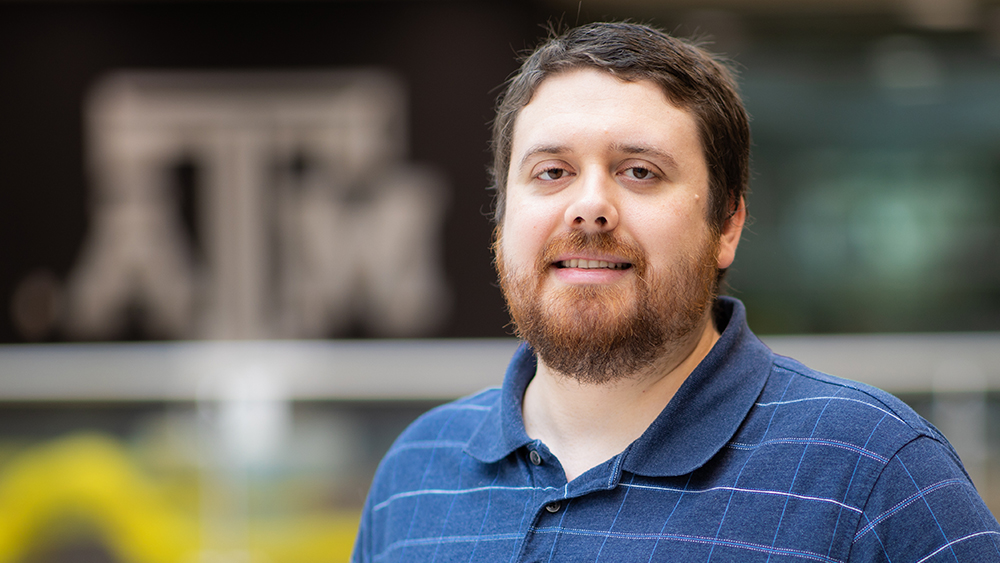
When engineers fracture a shale reservoir and connect natural networks of cracks so oil and gas can flow efficiently back to the well, they base their efforts on maps created by reservoir simulators. Since simulators often use probability to predict where these nearly invisible natural networks are, one researcher from Texas A&M University is eliminating the guesswork with a new method of mapping them.
Texas A&M student researcher Marcus Elliott is using the odd combination of electrical currents, called electromagnetics, and data from tightly-focused microseismic measurements to accurately render existing natural fracture networks in shale rock. His results, mapped in time-lapsed 3D, are more accurate and cost-efficient than current methods, and they also show which direction oil and gas flows during fracturing processes.
“This flow information is critical to engineers so they don’t waste time and money fracturing an area that won’t produce oil,” said Elliott. “And electromagnetics is a fairly inexpensive way to get this data.”
Cities use survey crews and equipment to measure and draw complex street maps so travel pathways are clearly defined. Similarly, reservoir simulators use measurements based on sound, called seismics, to illustrate the ‘streets’ or fractures existing underground. Unfortunately, these computer-generated maps aren’t accurate because natural fractures in a shale reservoir are often too small to show up clearly on seismic surveys. This invisibility means the simulator must guess where these networks of tiny cracks are based on mathematical probability. So, when engineers fracture a reservoir to connect the natural fracture networks and allow oil and gas to travel to the well, they base their efforts on guesswork.
Elliott’s initial step to clarify subsurface pathways was to create a base map of fractures in a reservoir using two different types of measurements. First, he broadcasted controlled-source electromagnetic (CSEM) waves into a reservoir. Receivers recorded the secondary electromagnetic wave signatures that returned to the surface. Any reservoir fluids that contained conductive materials, such as the salt in reservoir brines, reacted to these waves as if they were wires transmitting electricity, revealing the underground fracture networks the fluids traveled through to the array of receivers above ground.
The receiver recordings were then input into an electromagnetic simulator called Seatem, developed by Dr. Mark Everett’s group in the Department of Geology and Geophysics at Texas A&M, that mapped the fluid flow pathways in the fracture networks. Elliott then entered microseismic measurements of fractures taken from the same reservoir into the petroleum general unconventional reservoir utility simulator (GURU), developed by Dr. John Killough’s group in the Harold Vance Department of Petroleum Engineering at Texas A&M, which mapped the location of these fractures.
In his next step, Elliott used CSEM during an industry-induced fracturing process. Since the hydraulic fracturing fluids pumped into the reservoir were also conductive, the surface arrays detected how the fluids traveled away from the well and back again. He mapped the results in Seatem and later transferred this information into GURU. The final depiction accurately illustrated the fracture networks while also revealing which networks allowed fluid to flow and which areas trapped fluid.
“Electromagnetics show the movement of conductive fluids in subsurface cracks, no matter what their size,” Elliott said. “The CSEM data showed how the fracture networks connected together during production, and the microseismic data showed where the fracturing occurred.
Merging this information is the key to solving inaccuracies in mapping hydraulic fracturing field patterns.”
The idea of combining geophysics and petroleum engineering measuring methods came naturally to Elliott, who holds bachelor’s degrees in both fields. He is currently pursuing a doctoral degree in petroleum engineering. His advisors, Everett and Killough, are overseeing his work to make sure Elliott does the best job possible.
“Many of the physics and principles are the same in both fields, but combining the simulation work is complicated,” said Elliott. “So far, we’re getting a very clear understanding of what’s happening in the far field away from the well.”
Elliott is currently investigating ways in which Seatem can accurately map the stresses that happen when fractures form in the first section nearest the wellbore, the least defined area of his simulations.
“Much of the uncertainty we have comes from not knowing whether we are actually producing from areas of the subsurface that have been fractured,” said Elliott. “Combining microseismic and CSEM data will help alleviate this uncertainty, and it can solve some complex problems. Plus, it’s more efficient. Doing a better job of describing fractures not only helps oil production but can also change how we design fractures in the future.”